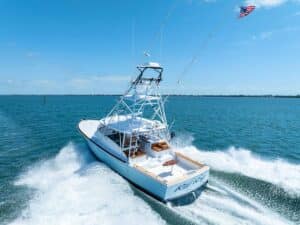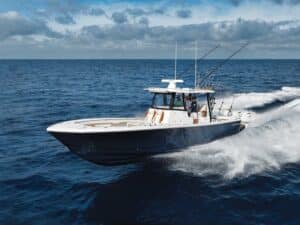Located in the 175-acre Jarrett Bay Marine Park in Beaufort, North Carolina, Jarrett Bay Boatworks is a diversified sales and service yard for recreational and commercial boats up to 140 feet, and home of Jarrett Bay’s custom sport-fish construction. It all started with a dream, an old shed with a leaky roof, and a boat named Sensation.

M: Let’s talk about your early days. How did you get into fishing?
I grew up in a passionate fishing family, and we had a 23-foot boat that my father trailered every weekend. An uncle in South Carolina had a charter boat, and when I figured out you could get paid to go fishing, I knew that was for me. The other kids wanted to be cops or firemen, but I wanted to be a charter captain. I sat for my U.S. Coast Guard license on my 18th birthday; the next day, I ran my first paid charter and caught a big load of mackerel. I was making a living, but during those duck-hunting charters in winter, which is brutal work, I learned it was a tough way to support a family.
M: How did your boatbuilding career develop?
I never wanted to be a boatbuilder; I wanted to fish. One day, I had the chance to fish with Omie Tillett on his boat, Sportsman, and it impressed me the way it ran in the ocean, better than any boat I had been on. When I asked Omie about building a boat, he gave me a sheet of paper with bottom shapes, heights and offsets, but his most influential wisdom was that there were no secrets. He said: “If we can’t help each other, what have we really accomplished? If we work together, we can build a much better product.” I had never built a boat before, but Omie and many others never said no when I asked questions. Their faith in what I could do built my confidence.

M: How did Jarrett Bay Boatworks come to be?
In late 1986, two regulars from my charter-fishing parties loaned my partner and me what we needed to build our first boat because we couldn’t get anything from the banks. We found an old building in Williston, North Carolina, on Jarrett Bay. The rent was $250 a month, and it had dirt floors and a leaky roof that let in rain and snow. One of my first calls was to order a drum of West System epoxy resin. The operator asked me the name of the company, and I told her that we didn’t have one yet. She said they needed to ship that quantity of epoxy to a manufacturer, not an individual, so I looked out the window and said, “I’m Jarrett Bay Boatworks,” and the order was on its way. We started building the 52-foot Sensation in December 1986, and finished that boat in January 1988. When it was completed, another charter captain came by and asked us to build him one. And before we finished that boat, we had orders for two more. It occurred to me that boatbuilding might be a better way to supplement our fishing income after all.
But the boat we built for Jack Huddle in 1990 really changed the direction of Jarrett Bay Boatworks. The previous Jarrett Bays were all built for charter, but he wanted a different look. This new boat had it all, from its pecan interior joinery to the teak decks in the cockpit. It showed the world that Jarrett Bay Boatworks could build more than just hardworking charter-fishing boats; we could also build top-quality luxury yachts too.
M: How many Jarrett Bays have been built?
We are starting on Hull 66 right now and have five others from 64 to 90 feet in production. That makes 66 of our larger boats, from 27 to 90 feet, all cold-molded. We also have built about 30 fiberglass boats in the 32- to 34-foot range. Each boat is custom, and we treat each one as if it’s our own.

M: How has boatbuilding changed since you began?
The industry has become challenging on many fronts. It’s expensive, and how we expect a boat to perform has changed considerably. We used to build boats that went 15 knots. We now want our boats to cruise at 35 to 38 knots in rough seas, and we are outfitting them with redundant systems to make chasing blue marlin off the west coast of Africa a reality. We have had to press our suppliers to deliver better grades of materials that stand up to this environment. Speed will always be important, but safety even more so. Safety is our responsibility.
M: Your largest boat so far is a 90-footer, Jaruco. What will we see with that one?
First and foremost, the dedication that Jarrett Bay puts into every boat we build. Jaruco has been a three-year project. Without a point of reference, you wouldn’t know it is 90 feet, and that was our intent. With its open flybridge, long foredeck and a curvy deckhouse, it has that sleek Jarrett Bay look the owner wanted. He wanted a fishing boat, but he also wanted the interior to be what you would find on a motoryacht. The craftsmanship is nothing short of stellar.
We reviewed, discussed and examined every item and component that would go into the build process, and we tank-tested the model on five separate occasions at Marin in the Netherlands. We were very weight-conscious throughout the testing, running the model at speeds to 50 knots and finding what it would take to achieve this goal if the power became available. We are using carbon fiber in many places, from the stringers and bulkheads to the Pompanette helm seats on the bridge. The running gear is unique to minimize turbulence at the propellers. The propeller shafts are made from titanium, saving 1,700 pounds. In all, we probably saved some 40,000 pounds to reach our displacement goal of around 160,000 pounds. **(See the build from the beginning here). **

M: What are the challenges facing the boatbuilding industry today?
We need to focus on a balance between commercial development and the protection of our watershed areas so the breeding grounds stay pristine. And we need to closely manage the commercial- and recreational-fishing quotas. The resources belong to all of us, so it’s up to all of us to manage it. Recreational anglers can sometimes feel like they don’t have a big impact on a fishery, and that’s not necessarily true. Let’s say there are 200 boats out fishing off Oregon Inlet for dolphin on a Saturday, and four guys on each boat catch their limit of 10 fish, and then you multiply that by 200; that’s a lot of fish — it makes a real impact. I think we have become better at what we do with circle hooks, and releasing billfish in good condition, but we need to educate more people about how important a safe release really is.
M: What is your advice for the marine industry as we move forward?
I believe it’s important for all of us in the industry to help new people who are just starting in this business. I’ve never turned anyone away who had a question or needed some advice about how we do something. That’s the legacy I would like to leave. Nobody ever told me they wouldn’t help me when I was first starting out. We have to offer others those same opportunities.








